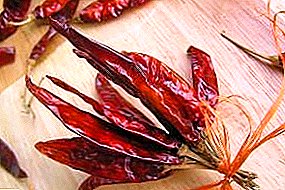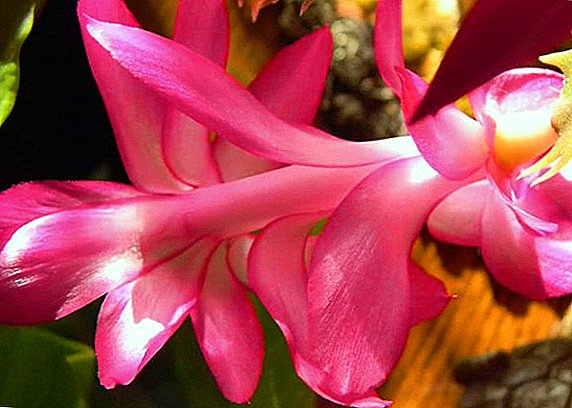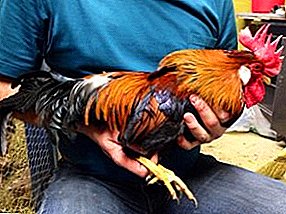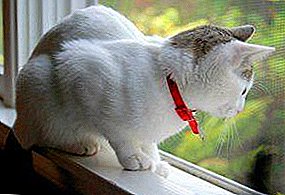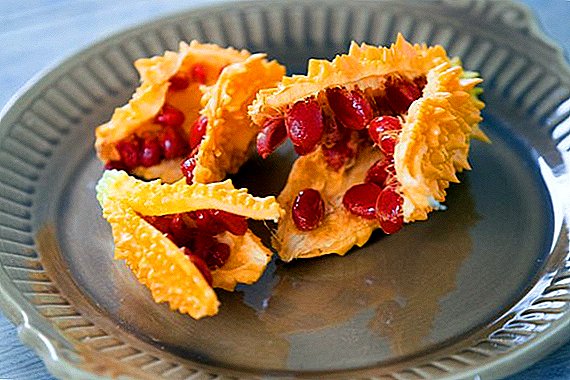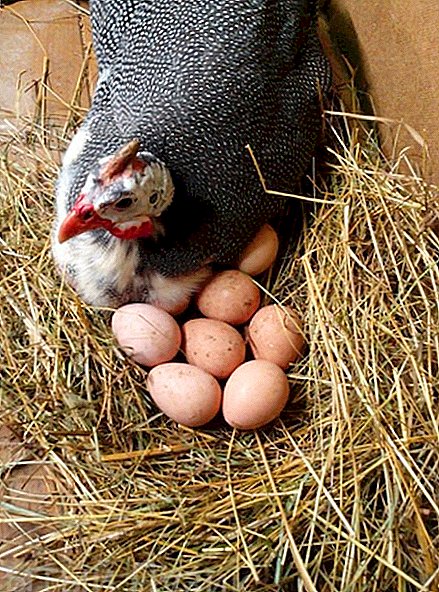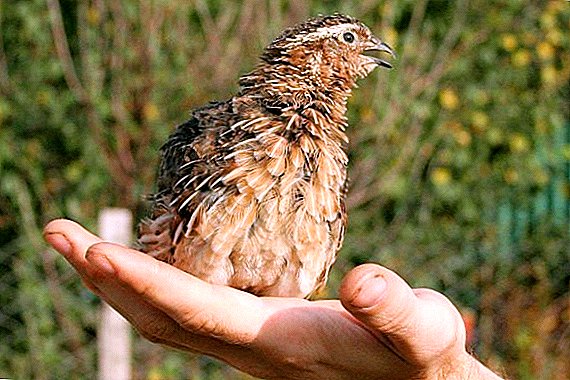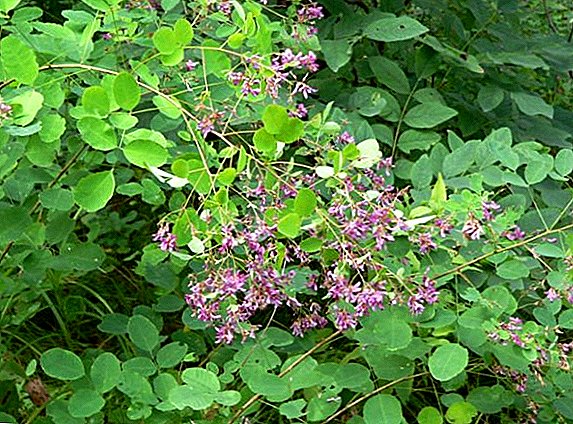 Nature has given us many different medicinal plants - some of them are known to everyone, few know about others. One of the lesser-known but useful herbs is Lespedeza. From this plant make tinctures, decoctions, brewed teas. For all its medicinal properties, contraindications and how to grow lespedetsu himself, read our article.
Nature has given us many different medicinal plants - some of them are known to everyone, few know about others. One of the lesser-known but useful herbs is Lespedeza. From this plant make tinctures, decoctions, brewed teas. For all its medicinal properties, contraindications and how to grow lespedetsu himself, read our article.
Botanical description
This perennial has short roots and a straight stalk that can reach 1.5 m in length. It is densely covered with dark green oblong leaves. Inflorescences form a brush; the flowers are a little similar in shape to the moths, each with five petals with purple stripes on a white or yellow background. The plant begins to bear fruit in early fall. The beans are beige with gloss, oval-shaped.
Chemical composition
Lespedets have many important components for humans - catechins, phenol carboxylic acids, various flavonoids and microelements.
Flavonoids:
- quercetin;
- bioquercetin;
- lesbedin;
- kaempferol;
- vitexin;
- orientin;
- homoorientin;
- saponaretin.
Learn more about such medicinal herbs as: whitehead, yarutka, walker, onosma, bitter creeping, centaury, astragalus, bonfire, bedworm, sedge, book, pike, yasnotka and zubrovka.Trace elements:
- magnesium;
- selenium;
- iron;
- zinc;
- manganese;
- calcium;
- copper.
Important! The level of toxicity of this perennial is minimal, which makes it safe for humans and does not threaten to the body irritation.
Medicinal properties
The plant has a good healing effect, as it has the following properties:
- diuretic;
- immunomodulatory;
- anti-inflammatory;
- slag removal;
- antiherpetic;
- antioxidant;
- painkillers;
- antitumor;
- antihistamine;
- antibacterial;
- anti stress
 Also, thanks to lespedec, the water-salt balance is regulated.
Also, thanks to lespedec, the water-salt balance is regulated.Medical applications
The plant is widely used for the prevention and treatment of the following ailments:
- kidney diseases - urolithiasis, glomerulonephritis, pyelonephritis;
- nervous system problems - frustration, depression, stress, anxiety;
- conjunctivitis;
- otitis media and rhinitis, as well as other ENT disorders;
- dermatological problems - lichen, dermatitis, urticaria;
- atherosclerosis, atheromatosis;
- urinary ailments - cystitis, urethritis;
- preeclampsia, obesity, metabolic disorders;
- herpes;
- oncological diseases in the early stages.
When oncology, take a cup and aloe.
Harm and side effects
Side effects of drugs based on this plant have virtually no. The only thing that can happen is a manifestation of an allergy. But it is insignificant and is easily removed with the help of antihistamines. 
Contraindications
It is believed that Lespedec has no contraindications - except, of course, individual intolerance, which is rare. Therefore, it can be given to small children, and pregnant or lactating women. Although some sources still do not advise giving medications from lespedets to these categories of people. To be 100% sure, it is best to consult with your doctor in advance.
Important! Children, as well as patients with impaired liver function, are given not alcoholic tinctures, but waterborne ones.
Healing Drug Recipe
Now we will tell you how to prepare equally useful potions from this useful plant.
Decoction
This drink treats kidney disease, as well as carry out their prevention.  You will need:
You will need:
- Lespedeta - 1 tbsp. l .;
- water - 1 l.
Infusion
When urolithiasis and kidney stones, colds and fungal diseases use water infusion.  You will need:
You will need:
- Lespedeta - 2 tbsp. l .;
- boiling water - 1 l.
Tea
Drink tea to stimulate and increase the activity of the immune system.  You will need:
You will need:
- Lespedeta - 1 tsp;
- water - 25 ml.
Tincture
For vessels and joints, it is good to take tincture. You will need:
- dried lespedeza;
- vodka.
 You will need:
You will need:- dried lespedeza - 100 g;
- Vodka - 1 tbsp.
Did you know? French botanist Andre Michaux called this plant Cespedez - in honor of the Spanish governor Vincent Manuel de Cespedes y Velasco, who helped him in his research. However, when printing the text of the scientific work an error occurred - and the plant was accidentally designated as Lespedez. So perennial acquired a new name.
Growing Lespedeza
In order to successfully plant and grow a plant, as well as to collect and procure raw materials, you need to follow certain rules.
Grow home St. John's Wort, savory and oregano.
Choice of location and lighting
Lespedeza is unpretentious, so it perfectly adapts to various conditions. It develops without problems and in a light shade (but only in a light one, the plant still needs light) and in an open area. Lespedeza grows best on loose, well-drained lands with moderate humidity.  The most suitable temperature for it is that which corresponds to the moderate middle zone. But even a lespedean in a period of low temperatures can suffer from the cold. True, in the beginning of spring the ground part of the perennial is quickly restored.
The most suitable temperature for it is that which corresponds to the moderate middle zone. But even a lespedean in a period of low temperatures can suffer from the cold. True, in the beginning of spring the ground part of the perennial is quickly restored.
Substrate and fertilizer
Perennial necessarily need feeding. Fertilizers containing nitrogen or phosphorus will do; In the spring, organic fertilizers are additionally applied. Such dressings can be added to the water, which is watered the plant.
Sowing and reproduction
Plant propagate:
- mature seeds;
- strong root suckers;
- grafting.
 Lespedetsu planted with the help of seedlings. Choose the most suitable site for planting, not forgetting that the plant loves drained soil, and it simply does not tolerate stagnant moisture. Prepare a mixture of good garden soil and sifted sand. Add fertilizer there (a mixture of potassium, phosphorus, nitrogen). Liberally pour. Make soil mulch pebbles or gravel; You can use for this dry land from another site.
Lespedetsu planted with the help of seedlings. Choose the most suitable site for planting, not forgetting that the plant loves drained soil, and it simply does not tolerate stagnant moisture. Prepare a mixture of good garden soil and sifted sand. Add fertilizer there (a mixture of potassium, phosphorus, nitrogen). Liberally pour. Make soil mulch pebbles or gravel; You can use for this dry land from another site.Also find out why soil mulching is needed.
Watering and moisture
In the first years of life, lespedeza requires regular abundant watering - up to 10 liters of water per shrub. It is good to take rain or settled water, a few degrees warmer than air. Older plants should be given moisture only in the dry season. It tolerates a temporary decrease in humidity without problems. But this should be done gradually.
Harvesting and storage of raw materials
For medical preparations taken flower buds, leaves, stems. It is necessary to harvest raw materials during the period of budding, cutting off the leafy part of the bush at a height of 10-15 cm from the ground. Dry raw materials using dryers or under a canopy, spreading out a thin layer on paper. It is possible to produce drying in direct sunlight. If it is carried out indoors, by all means take care of the availability of good ventilation. Store lespedetsu in fabric bags or closed glass containers, in dry ventilated places. Keep the raw material is recommended no more than five years.
Did you know? Lespedetsa even has a beneficial effect on ... the ground. She satiates priming and stops the development of erosion. And its roots can interact with bacteria that accumulate nitrogen, so that it becomes a feed for plants.
 Thus, Lespedez certainly deserves your attention. If you consult with your doctor and will do everything according to the recommendations, you will definitely be able to benefit your body. And using our tips on perennial care, you can certainly grow this beautiful and healthy plant in your garden.
Thus, Lespedez certainly deserves your attention. If you consult with your doctor and will do everything according to the recommendations, you will definitely be able to benefit your body. And using our tips on perennial care, you can certainly grow this beautiful and healthy plant in your garden.

